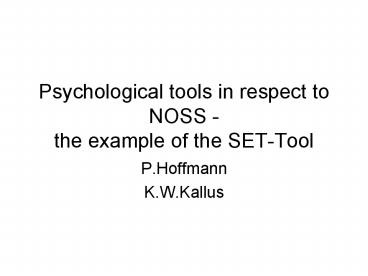Psychological tools in respect to NOSS the example of the SETTool - PowerPoint PPT Presentation
1 / 23
Title:
Psychological tools in respect to NOSS the example of the SETTool
Description:
Assesment of this traffic situation with the SET- Tool. Structured assesment of traffic situations every hour with the set-tool. Data set ... – PowerPoint PPT presentation
Number of Views:45
Avg rating:3.0/5.0
Title: Psychological tools in respect to NOSS the example of the SETTool
1
Psychological tools in respect to NOSS - the
example of the SET-Tool
- P.Hoffmann
- K.W.Kallus
2
- NOSS is based on the TEM Modell
- NOSS is obeserving the human behaviour in threat
and error situations - -threat management
- -error management
3
- LOSA and NOSS try to look for desired (e.g.
threat management) and undisered (errors,
deviations from procedures) variability in task
execution. - Goals
- Proficiency check
- Feedback on working pratices
- Establishment of best practices
- Refinement of procedures
- Bechmarking in TEM
- Devepment of professional task execution even in
non standard situations
4
- LOSA and NOSS center around tasks and their
execution. Thus methods from task analysis should
be checked for contributions - Two methods are recommended
- Reconstruction interviews
- SET-Tool
5
Safety-Efficiency-taskload ModellSET
ATCO have to guarantee at the same time Safety
Efficiency in adynamic traffic situation
situation which causes Taskload SET follows a
system dynamic approach
6
NOSS and SET
Safety buffer
Safety
NOSS
efficiency
taskload
Traffic mix Dynamic Density (Complexity) Number
of a/c Amount of requests Weather .....
Separation level Direct routing Requested
flightlevel
7
Questions
- What environmental and operational circumstances
causes - Reduction of the safety buffers
- Reduction of efficiency
- Reduction of taskload
8
Question
- What environmental circumstances interfere the
balance between - - SAFETY
- - EFFICIENCY
- - TASKLOAD
9
QUESTION
- which level of misbalance (unstability) between
safety, efficiency and taskload lead to
errors incidents accidents
10
The method
- Strip analysis
- Analysing specific traffic situations which had
deveated from the routine - Description of this situation
- Assesment of this traffic situation with the SET-
Tool - Structured assesment of traffic situations every
hour with the set-tool
11
Data set
- We get through this method a clear picture of
- - different levels of taskload
- - decisionmaking in favour of safety,
efficiency or taskload - - threats and threatmanagement
- - errors and errormanagement
12
Advantages of SET
- Training people one day
- The ATCOs are directly involved in the analysis
- The ATCOs get directly feedback
- The data can be easily stored in a SPSS programm
- The data collection can be compared and combined
with other psychological, physiological, traffic
data if required
13
Balanced System no additional s-buffer, average
efficiency, average taskload
14
Disbalanced System safety and efficiency are
kept by increased taskload (and workload)
15
Ergebnisse der SEW-Balance
16
Ergebnisse Objektive Belastung (EKG) bei
verschiedenen Arbeitsweisen
17
Ergebnisse Objektive Belastung (EKG) bei
verschiedenen Arbeitsweisen
18
Unbalanced System no additional s-buffer,
reduced efficiency, increased taskload and
workload
19
Unbalanced System reduced safety-buffer, average
efficiency, high taskload
20
Balanced System no additional s-buffer, average
efficiency, average taskload
21
Validity of SET(Vormayr Kallus, 2005)
- Grafiken 4.26-4.28 aus Vormayr Arbeit.
- PC simulated scenarios, which differend in
dynamic density were rated twice by controllers
using the SET-Tool. There a highly significant
effects of dynamic density.
22
Validity of SET(Winkler, Hoffmann Kallus, 2006)
- Ggf einfügen von Di
- Reconstruction interviews after full shift
observations show clear cut differences between
normal traffic situations and those, which
approach the level of individually critical
traffic situations
23
Conclusions
- Tools from task analyses in ATC (and cockpits)
might add valuable information to LOSA and NOSS
especially in cases in which professional task
performance is to be improved and best practices
for threats should be developed. - Feedback (and feedback rules) has to be an
essential element of LOSA and NOSS approaches































